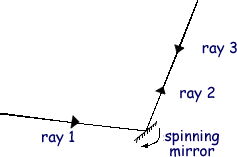Questions on Light
Q12. A spinning mirror can be used to measure the speed of light. The experiment is shown below.

Ray 1 is incident on the spinning mirror.
Ray 2 is the reflection of ray 1 from the spinning mirror.
Ray 3 is the reflection of ray 2 from a small fixed mirror 2.0 m away. It travels back along the same path as ray 2.
(a) Describe how the small fixed mirror is positioned so that the light is reflected back along the same path.
The small mirror must be fixed perpendicular (at a right angle - at 90o)  to the incident ray if it is to reflect the ray back along its path.
to the incident ray if it is to reflect the ray back along its path.
1 mark
When ray 3 reaches the spinning mirror, it is again reflected to form ray 4. Its path is very close to ray 1 and therefore it has not been drawn on the diagram. Much less light travels along ray 4 than along ray 1.
(b) Suggest one reason why less light travels along ray 4 than along ray 1.
any one from 
- some light is absorbed at each reflection
- half or some of the light from ray 1 hits the back of the spinning mirror most of the light reflected from the spinning mirror misses the small or fixed mirror OR 'some of the light goes in a different direction'
- some light is scattered from air particles OR 'the beam diverges' OR 'the light spreads out'
1 mark
Ray 4 does not travel back along exactly the same path as ray 1 because the spinning mirror has moved between the two reflections.
(c) The spinning mirror rotates 40 times per second.
(i) How long does it take to turn through an angle of 1°? Give the correct units.
It rotates 360o in 1/40 s
so it will rotate 1o in 1/(40x360) s
= 6.9 x 10-5 s
= 69  s
s 
1 mark
(ii) The mirror is found to have turned through an angle of 0.0002° between the two reflections. What is the time interval between the reflections? Give the correct units.
answer to part (i) x 0.0002
= 0.0002 x 6.9 x 10-5 s
= 1.4 x 10-8s 
1 mark
(d) The distance between the fixed mirror and the spinning mirror is 2.0 m. What value does this experiment give for the speed of light? Show your working and give the correct units.
speed = distance travelled/time taken 
distance travelled = 2 x 2.0m = 4.0 m  (there and back!)
(there and back!)
= 4.0 / (1.4 x 10-8) = 3.0 x 108 m/s 
3 marks
Maximum 7 marks







